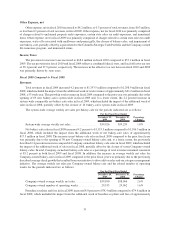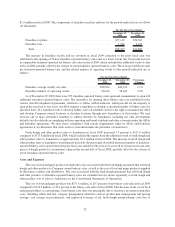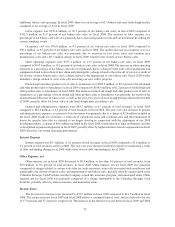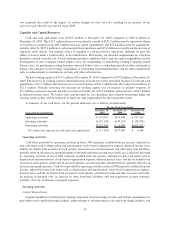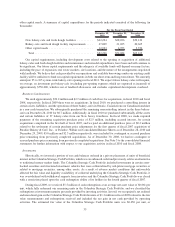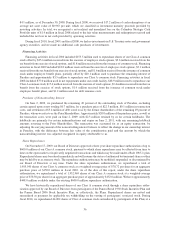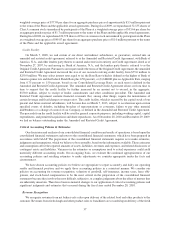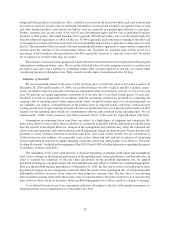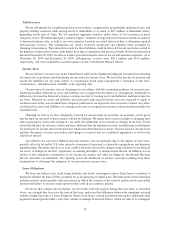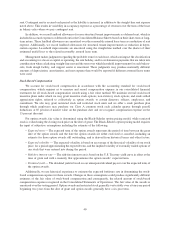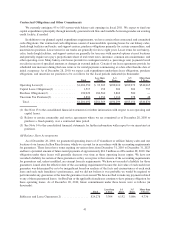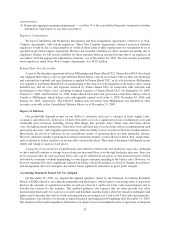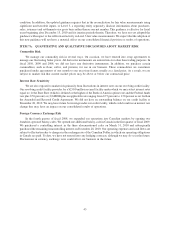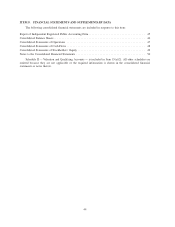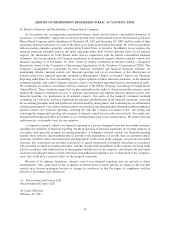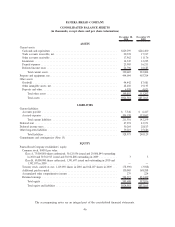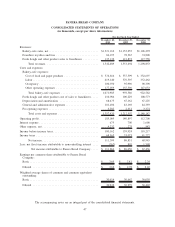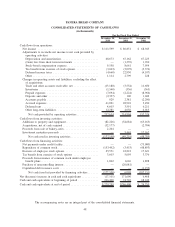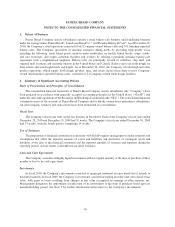Panera Bread 2010 Annual Report Download - page 47
Download and view the complete annual report
Please find page 47 of the 2010 Panera Bread annual report below. You can navigate through the pages in the report by either clicking on the pages listed below, or by using the keyword search tool below to find specific information within the annual report.rent. Contingent rent is accrued each period as the liability is incurred, in addition to the straight-line rent expense
noted above. This results in variability in occupancy expense as a percentage of revenues over the term of the lease
in bakery-cafes where we pay contingent rent.
In addition, we record landlord allowances for non-structural tenant improvements as deferred rent, which is
included in accrued expenses or deferred rent in the Consolidated Balance Sheets based on their short-term or long-
term nature. These landlord allowances are amortized over the reasonably assured lease term as a reduction of rent
expense. Additionally, we record landlord allowances for structural tenant improvements as reduction in depre-
ciation expense. Leasehold improvements are amortized using the straight-line method over the shorter of their
estimated useful lives or the related reasonably assured lease term.
Management makes judgments regarding the probable term for each lease, which can impact the classification
and accounting for a lease as capital or operating, the rent holiday, and/or escalations in payments that are taken into
consideration when calculating straight-line rent and the term over which leasehold improvements for each bakery-
cafe, fresh dough facility, and support center is amortized. These judgments may produce materially different
amounts of depreciation, amortization, and rent expense than would be reported if different assumed lease terms
were used.
Stock-Based Compensation
We account for stock-based compensation in accordance with the accounting standard for stock-based
compensation, which requires us to measure and record compensation expense in our consolidated financial
statements for all stock-based compensation awards using a fair value method. We maintain several stock-based
incentive plans under which we may grant incentive stock options, non-statutory stock options, and stock settled
appreciation rights, referred to collectively as option awards, to certain directors, officers, employees, and
consultants. We also may grant restricted stock and restricted stock units and we offer a stock purchase plan
through which employees may purchase our Class A common stock each calendar quarter through payroll
deductions at 85 percent of market value on the purchase date and we recognize compensation expense on the
15 percent discount.
For option awards, fair value is determined using the Black-Scholes option pricing model, while restricted
stock is valued using the closing stock price on the date of grant. The Black-Scholes option pricing model requires
the input of subjective assumptions including the estimate of the following:
•Expected term — The expected term of the option awards represents the period of time between the grant
date of the option awards and the date the option awards are either exercised or canceled, including an
estimate for those option awards still outstanding, and is derived from historical terms and other factors.
•Expected volatility — The expected volatility is based on an average of the historical volatility of our stock
price, for a period approximating the expected term, and the implied volatility of externally traded options of
our stock that were entered into during the period.
•Risk-free interest rate — The risk-free interest rate is based on the U.S. Treasury yield curve in effect at the
time of grant and with a maturity that approximates the option awards’ expected term.
•Dividend yield — The dividend yield is based on our anticipated dividend payout over the expected term of
the option awards.
Additionally, we use historical experience to estimate the expected forfeiture rate in determining the stock-
based compensation expense for these awards. Changes in these assumptions could produce significantly different
estimates of the fair value of stock-based compensation and consequently, the related amount of stock-based
compensation expense recognized in the Consolidated Statements of Operations. The fair value of the awards is
amortized over the vesting period. Option awards and restricted stock generally vest ratably over a four-year period
beginning two years from the date of grant and option awards generally have a six-year term.
40



